Mustard, wheat, vegetables, millets – one of the most fertile valleys in the Himalayas is able to show a bumper harvest, thanks to the traditional irrigation channels that bring the water of the Gagas river to the farms in this part of Kumaon in the state of Uttarakhand.
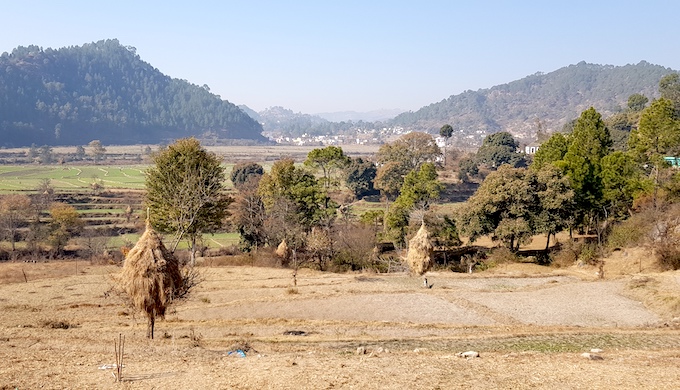
Gagas valley in Uttarakhand, irrigated by the Gagas river. Image: Hridayesh Joshi
“River Gagas is our main source of drinking water and irrigation. Canals (from the river) bring water to the fields and make this (agriculture) possible for us”, says 27-year- old Bhupendra Singh Bisht, a resident of Rawalsera village in the valley.
Gagas is one of the myriad spring-fed rivers without which life would be almost impossible in the Himalayas. While large glacier-fed rivers such as the Ganga, Brahmaputra or Indus get all the attention, the relatively small spring-fed rivers in the middle Himalayas are what sustain the people.
The big rivers form gorges so deep that it is difficult to fetch water from them for everyday use. In most places, those gorges are too steep to farm on the riverbanks.
In contrast, the spring-fed rivers start in the forests at the top of local hills, flow through relatively wider valleys and finally meet the larger glacier-fed rivers, a crucial source of water in the winter when there is very little flow from the hard-frozen glaciers. A maze of irrigation channels (locally called gul) take the water from the rivers to the fields and return the water downstream after irrigation.
“The entire gul system developed in Uttarakhand and Himachal Pradesh is fed by these non-glacial rivers,” says Yogesh Gokhale, Senior Fellow, Forestry and Biodiversity Division at the New Delhi-based think tank, The Energy and Resources Institute (TERI).
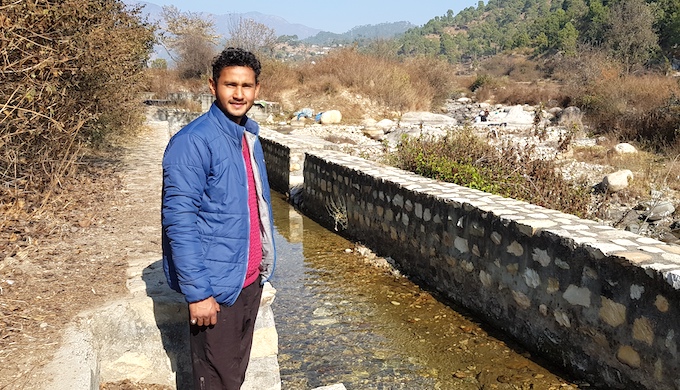
Bhupendra Singh Bisht shows a water channel (gul) that flows from the Gagas river and irrigates farms in the valley. Image: Hridayesh Joshi
The Gagas river rises from a spring in the forests of Bhatkot in Almora district. It flows around 125 kilometres before merging into the Ramganga (West) at Bhikiasain. During its short journey, as many as 70 rivulets meet the Gagas, making it the river that caters to household and irrigation needs of over 100,000 people.
Forest rivers
In the Himalayas, there are many non-glacial rivers such as the Gagas. In Kumaon, there are the Gomti, Garudganga, Panar, Kosi, Bino, Gaula and so on. Locally, they are called “forest rivers”, because that is where they are born. Together, they form an intricate web that is the backbone of perennial water supply in the Ganga basin.
“In 1992 when the first (earth) summit was organised in Rio de Janeiro the Himalayan glaciers were termed water towers of the 21st century. I have been saying since then that though glaciers are definitely water towers, but the forests are too,” says the doyen of environmental historians Shekhar Pathak.
“In fact, they are double water towers because they not only preserve and maintain water in the ground, but also release water when in winters the glaciers don’t melt, and the snowy rivers don’t give you water. For three to four months the environment does not allow the river to flow. That is the time when these non-glacial rivers continue to supply water to these perennial rivers.”
Critical for the survival of local communities, these rivers have religious, mythological and historical importance. Gomti and Garudganga meet at the temple town of Baijnath, which was the capital of the Katyuri kings between 800 and 1100 CE.

The confluence of Ramganga (West) and Bino at Budha Kedar near Ranikhet in Uttarakhand, Ramganga is one of the largest forest rivers in Uttarakhand. Image: Hridayesh Joshi
Watershed destruction
Today, all these rivers are in danger.
The main threat is deforestation. Ill-planned road construction, housing and hydropower dams have led to trees being cut down. Add to that encroachment on forests for agriculture, horticulture and pasture. In Uttarakhand, over 45,000 hectares of forest land have been diverted to other use since 1980. Trees in over 60% of these “diverted” areas have been felled since 2000.
Forests act like sponges to hold rainwater and release it slowly. The felling of trees has dried out many of the springs from which these “forest rivers” start.
The pressure of population has increased rapidly on hill towns of Uttarakhand. India’s decadal Census shows that urban population of the state has doubled in the last two decades. The populations in urban areas has jumped from 1.63 million (22.97%) in 2001 to 3.09 million (30.55%) in 2011. The population of Haridwar and Udham Singh Nagar – towns in Uttarakhand – increased by 30.63% and 33.45% respectively between 2001 and 2011. Population of the hill districts of Nainital, Champawat and Uttarkashi increased by 25.13%, 15.63% and 11.89% respectively in the same period.
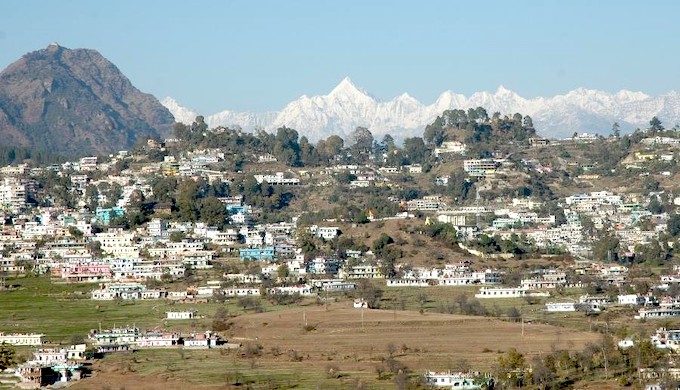
A view of Pithoragarh, a town growing fast, all unplanned and haphazard. Image: Vipin Gupta
“Villages are getting emptied. People are migrating from remote areas not only to plains but also to hill towns. Besides big towns like Pithoragarh, small settlements like Didihaat and Berinaag are also getting crowded. The trend has sharply increased in the last 20 years.” says 39-year-old Komal Singh Mehta, who lives in Pithoragarh.
This migration has resulted in rapid construction for housing and business. Forests have been cut to make space for buildings, including for hotels and resorts to boost tourism. All this in the absence of any planning and through violation of norms. Catchments are being destroyed and the hydrology of the region has been disturbed.
“The growth is unlimited and it is all unplanned. We have seen hill towns like Almora growing as much as five times in the last fifty years. All the construction is done over the places where there used to be wells. Now as the buildings have been constructed over them the wells are gone. This has affected the catchment,” says G.C.S. Negi, scientist with the G.B. Pant National Institute of Himalayan Environment and Sustainable Development at Almora.
Environmental norms and laws are frequently violated during road construction across the mountains. Trees are cut without any clearance from the forest department and debris thrown into the rivers below. The process has significantly increased the number of landslides in the region.
The biggest example is the 900-km Chardham Yatra Marg project to connect four major Hindu shrines in Uttarakhand. The controversial project has seen felling of as many as 50,000 trees. The state and central governments have been touting the project as a state of the art “all weather highway”, even as the matter is pending in court for violation of environmental laws and not obtaining mandatory clearances.
Environmental experts and earth scientists have criticised the project for dumping debris in the rivers and excavating mountainsides in an ecologically sensitive region.
“Unfortunately, in recent times indiscriminate growth of projects have compromised the future of these smaller streams by striking at their very vitals, namely aquifer connectivity and facilitating greens,” says Manoj Mishra, retired official of the Indian Forest Service and now an activist seeking to revive the Yamuna river. “Char Dham all-weather road construction activities resulting in loss of thousands of trees and drying of springs is a case in point.”
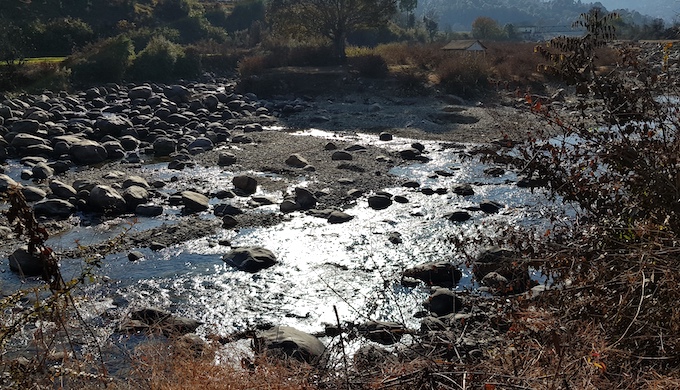
River Gomti meets another important non-glacial river Garudganga in the historic town of Baijnath in Uttarakhand. Image: Hridayesh Joshi
Depleting groundwater
The cutting down of forests affects percolation of water underground, drying up the water channels (known as nallas and gadheras in Kumaon) that feed the non-glacial rivers. Resident Ram Singh Bhandari, 51, talks of two main reasons for the drying up. “The rainfall isn’t as much as it used to be 25 years back. Another reason is the method adopted for the drinking water supply schemes by (government) departments. They have dug borewells and extracted all the groundwater.”
All over Kumaon, hand pumps can be seen along the roadside and in the villages. “These hand pumps extract ground water, so naulas (shallow wells) have dried up. These (wells) are very important for groundwater recharge that keeps the springs alive,” says 52-year-old Charu Tiwari, who has been part of several environmental movements in Uttarakhand.
“Correct way to provide water is make supply line from the rivers (to the villages) but the authorities have found an easy answer. They dig and encourage borewells,” says Tiwari while showing the famous Dosad ka Gadhera (a water channel) in Bagwalipokhar which is dry now. “There was a time some 25 years ago when this Dosad ka Gadhera had so much water we couldn’t cross it. But you can see what is left now. Such water channels are the feeders of forest rivers.”
The climate change effect
Long spells of dry weather punctuated by cloudbursts are becoming frequent in the Himalayas. Experts in the Intergovernmental Panel on Climate Change have ascribed this to climate change. The effect on receding of glaciers is better known globally. But for the residents, the erratic rainfall pattern is just as destructive, if not more.
“In the last 30-40 years the behaviour of weather is entirely different from what it was earlier,” says Shekhar Pathak. “Now nowhere do you feel that this is natural. Either it is surplus water or it is long drought. In some parts of outer Himalaya between September and next June there is no snowfall or rainfall.”
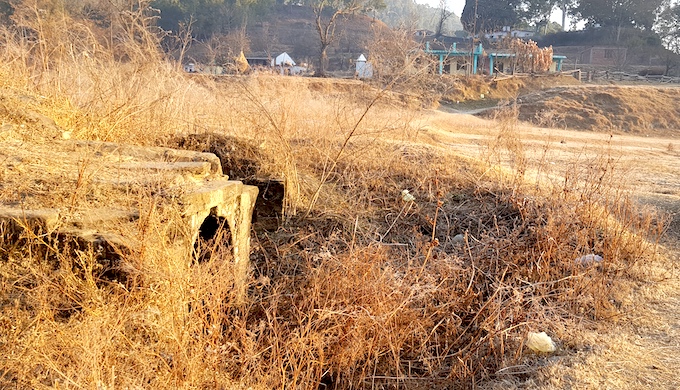
Such water channels were once alive and fed non-glacial rivers. Image: Hridayesh Joshi
People power
Modern India’s ecological consciousness was born largely out of Uttarakhand’s Chipko movement in the 1970s, when women clung to trees to save forests. Now, the women are again taking charge to protect forests and plant the species that hold moisture and recharge groundwater.
Women in Thaman village of the Gagas valley are showing the way.
“Here we have planted around 800 trees,” says Hema Devi, leader of the Mahila Mangal Dal, a community group of women. “We also made some trenches and dug the ground (to make small ponds). As a result, we now have some water here.”
What variety of trees did they plant? “We planted trees with broad leaves like oak, rhododendron, basil and gooseberry. Her companions say they want to recharge the wells by rejuvenating the forest. “We noticed the falling water level and bad health of streams but now we are taking care of the forest,” adds Hema Devi. “The result is slow, but we are moving in the right direction. We can see the water level is improving in our almost dead wells.”
Such efforts have resulted in an initiative, the Naula foundation, a movement to save wells with the participation of women and young volunteers. Foundation member Manoj Pande, 52, shows the results in Panergaon and Dhankhal, where they have planted oak and rhododendron. “I started plantation in 1998 when this place had become barren and the wells had dried up. People would say nothing can happen, don’t waste your time. I was determined to grow this forest. Today you can see the difference.” The trees are thriving, and the wells have water.
Making trenches is another popular and effective way to increase the groundwater level and recharge the dead springs and water streams. Villagers have successfully implemented the technique in Uttarakhand with the help of experts.
The efforts of these passionate villagers become more critical as experts caution against the continued migration from remote areas in the mountains. They underline that habitation is necessary to protect the catchment. “Up in the mountains catchments are very badly managed. They are extremely damaged. People are coming down from higher altitudes leaving behind non-maintained watershed catchments. There is no availability of people to take care of bunds of farmlands and terraces resulting in extreme deterioration of landscape and also the watershed,” says Yogesh Gokhale.
—
Source: India Climate Dialogue
